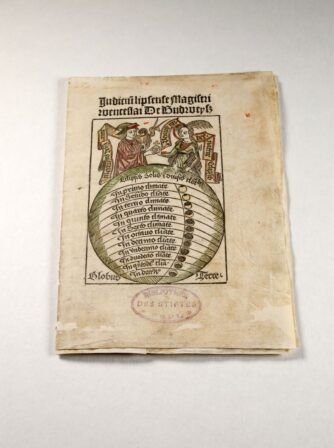Bibliotheca astronomica. Astronomical Books from the 15th–17th Centuries in the Collection of the National Library of the Czech Republic
Galerie Klementinum, 18. 10. – 18. 12. 2024
The Bibliotheca astronomica exhibition provides a unique opportunity to view rare printed books on astronomical topics, the oldest ones dating from the first quarter of a millennium after the invention of the printing press.
The project, as part of which the exhibition is devised, investigates the original libraries of scientists and scholars (so-called provenance research). Reconstructions of primarily private, as well as institutional libraries, and research of incunabula and early printed books have provided interesting information on the lives and mutual communication of astronomers, the scientific (or popular) content of their works, significant printing workshops, and the owners or the sequence of the owners of the books published.

NK ČR, sign. Teplá fragm. 528
The first part of the exhibition reflects the involvement of people from Bohemia in the publication of astronomical literature (e.g. the humanist Augustinus Olomoucensis) and the development of specialised book collections by both lay people interested in astronomical studies (e.g. graduates of Italian universities Bohuslav Hassenstein von Lobkowicz and Valentin Meziříčský) and professional astronomers (e.g. Wenzel Faber, born in České Budějovice).

The exhibition presents rare books from the 15th-18th centuries collected by astronomers interested in new astronomical discoveries or well-known bibliophiles. Rare astronomical prints of the oldest Bohemian astronomers as well as books owned by famous astronomers, the Clementinum Mathematical Museum or monasteries where science was cultivated.
Rare early printed books in the second part of the exhibition are partly the new re-editions of astronomy works by ancient and medieval authors, but mainly new books from the 16th and 17th centuries. The most interesting are Astronomicum Caesareum by Peter Apian (1540), De revolutionibus orbium coelestium by Nicholas Copernicus (1566), astronomy books by Tadeáš Hájek of Hájek (1574 and 1578), Astronomiae instauratae mechanica by Tycho Brahe (1598), Astronomiae pars optica with the author’s dedication of Johannes Kepler to the Collegium Carolinum professors (1604) and his Rudolphine Tables (1627), Dialogues by Galileo Galilei (1635), extensive treatises by Johannes Hevelius (1647 and 1668), and Bohemian Jesuit books (1621–1687), some of which were written by Bohemian Jesuits on missions in distant lands.
The owners are most frequently identified by ownership notes, sporadically by supralibros and pasted-in ex libris or by the typical arrangement of book spines. It is certainly a pity that the journey of astronomy books through centuries in many cases has not been documented in detail. Yet at least some have left their mark on the book.

The exhibition not only presents the groundbreaking discoveries of astronomy and ancient views of the universe, but also offer aesthetic experiences: Incunabula, i.e. books published before1501, accompanied by woodcut diagrams or symbols of the planets and constellation symbols, early prints with multi-layered rotating models of planetary movements, hand-coloured illustrations or engraved frontispieces and title pages that combine expert astronomical illustrations with landscape, mythological and religious elements.
The exhibits have been selected from the historical collections of the National Library of the Czech Republic. They are supplemented with reproductions of other unique astronomy publications kindly provided by the National Museum Library, Library of the Royal Canonry of Premonstratensians at Strahov, Olomouc Research Library, Lobkowicz Library in Nelahozeves, Library of South Bohemian Museum in České Budějovice, Křivoklát Castle Library, and Austrian National Library in Vienna.

An exhibition catalogue has been prepared to accompany the exhibition, which is one of the results of the joint research project of the National Library of the Czech Republic, National Museum, National Heritage Institute, Library of the Czech Academy of Sciences, and Olomouc Museum of Art whose content is focused on research of book provenance, the history of libraries, and related aspects of book culture. The project “Roots and Fruits of European Science in Bohemian, Moravian and Silesian Historical Library Collections” (DH23P03OVV058) is supported by the Ministry of Culture of the Czech Republic under the Programme to Support Applied Research and Experimental Development in the Field of National and Cultural Identity (NAKI III).
https://www.en.nkp.cz/about-us/specialist-and-cultural-events/exhibitions